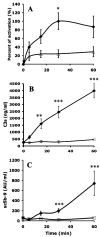Acute antibody-mediated complement activation mediates lysis of pancreatic islets cells and may cause tissue loss in clinical islet transplantation
- PMID: 18431241
- PMCID: PMC2692616
- DOI: 10.1097/TP.0b013e31816b22f3
Acute antibody-mediated complement activation mediates lysis of pancreatic islets cells and may cause tissue loss in clinical islet transplantation
Abstract
Background: Clinical islet transplantation is associated with loss of transplanted islets necessitating tissue from more than one donor to obtain insulin independence. The instant blood-mediated inflammatory reaction (IBMIR) is one explanation to the tissue loss. Complement activation is an important cytotoxic component of the IBMIR, and in the present study, we have investigated this component in detail.
Methods: Isolated human islets were analyzed by large particle flow cytometry and confocal microscopy after incubation in human ABO-compatible hirudin-plasma.
Results: After incubation in plasma, the islets bound IgG and IgM, CIq, C4, C3 and C9. The binding of C3b/iC3b was evident already after 5 min. The binding of C3b/iC3b and the generation of C3a and sC5b-9 were inhibited by the complement inhibitor Compstatin. Lysis as reflected by propidium iodide (PI) staining and release of C-peptide was also inhibited by Compstatin. There were significant correlations between IgM/IgG versus C3b/iC3b and between sC5b-9 and C-peptide.
Conclusion: The conclusion is that complement is activated by natural IgG and IgM antibodies already after 5 min. The complement activation leads to lysis of cells of the pancreatic islets. This very rapid reaction may be an essential entity of the damage induced by the IBMIR in clinical islet transplantation.
Figures





References
-
- Shapiro AM, Lakey JR, Ryan EA, et al. Islet transplantation in seven patients with type 1 diabetes mellitus using a glucocorticoid-free immunosuppressive regimen. N Engl J Med. 2000;343:230. - PubMed
-
- Eich T, Eriksson O, Lundgren T. Visualization of early engraftment in clinical islet transplantation by positron-emission tomography. N Engl J Med. 2007;356:2754. - PubMed
-
- Eich T, Eriksson O, Sundin A, et al. Positron emission tomography (PET): A real time tool to quantify early islet engraftment in a pre-clinical large animal model. Transplantation. 2007;84:893. - PubMed
-
- Ryan EA, Lakey JR, Rajotte RV, et al. Clinical outcomes and insulin secretion after islet transplantation with the Edmonton protocol. Diabetes. 2001;50:710. - PubMed
-
- Ryan EA, Paty BW, Senior PA, et al. Five-year follow-up after clinical islet transplantation. Diabetes. 2005;54:2060. - PubMed
Publication types
MeSH terms
Substances
Grants and funding
LinkOut - more resources
Full Text Sources
Other Literature Sources
Medical
Research Materials
Miscellaneous

